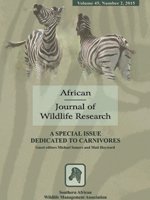Andrew B. Stein, Sven L. Bourquin, J. Weldon McNutt
African Journal of Wildlife Research 45 (2), 247-257, (1 September 2015) https://doi.org/10.3957/056.045.0247
KEYWORDS: interspecific competition, Panthera pardus, food caching
Leopards (Panthera pardus) are the most widely distributed wild felid in the world, living sympatrically with numerous competitively dominant species in various large carnivore guilds. Leopards generally feed on small to medium-sized ungulates and risk kleptoparasitism from intraguild competitors. One unique, adaptive response to intraguild competition is arboreal caching (‘hoisting’) by leopards. Hoisting behaviour is thought to vary in frequency among individuals, populations, and between sexes. In our study, leopards fed primarily (85% of observed kills) on impala (Aepyceros melampus), which is the most locally abundant potential prey species. Although we did not detect statistical differences in hoisting rates among individuals within each sex, our results confirmed moderate hoisting rates of 35% in an area with medium densities of lions (Panthera leo), spotted hyaenas (Crocuta crocuta) and African wild dogs (Lycaon pictus). Sex differences in prey hoisting were related to size, and males as the larger sex, hoisted kills (47.7%, n = 44) more often than overlapping females (27%, n = 62). Female leopards hoisted 25–33% of detected kills irrespective of prey size, season, habitat type, presence of dependent cubs, or location in relation to high competitor density areas (‘competitor hotspots’). Consistent with this, males hoisted kills more often where visibility and, therefore, probability of detection was highest. We conclude that hoisting is likely correlated with energetic costs, seasonally increased detection by competitors, and direct competitor interactions rather than the potential risk of conflicts within generalized areas of high competitor use (‘hotspots’).


